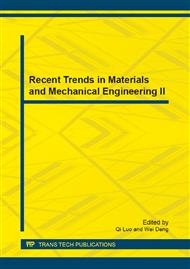[1]
M.B. Karamış, A. Taşdemirci, F. Nair, Microstructural analysis and discontinuities in the brazed zone of copper tubes, Journal of Materials Processing Technology, 141 (2003) 302-312.
DOI: 10.1016/s0924-0136(03)00281-4
Google Scholar
[2]
J.R. davis, Copper and Copper alloys, First ed., ASM international, Ohio, (2001).
Google Scholar
[3]
S. Baragetti, A. Terranova, M. Vimercati, Friction behaviour evaluation in beryllium–copper threaded connections, International Journal of Mechanical Sciences, 51 (2009) 790-796.
DOI: 10.1016/j.ijmecsci.2009.09.004
Google Scholar
[4]
W.D. Callister, D.G. Rethwisch, Fundamentals of Materials Science and Engineering, An Integrated Approach, Third ed., John Wiley & Sons Inc., Hoboken, (2008).
Google Scholar
[5]
E.P. Bandarra Filho, J.M. Saiz Jabardo, Convective boiling performance of refrigerant R-134a in herringbone and microfin copper tubes, International Journal of Refrigeration, 29 (2006) 81-91.
DOI: 10.1016/j.ijrefrig.2005.05.011
Google Scholar
[6]
Rex Miller, M.R. Miller, Air Conditioning Home & Commercial, fifth edition ed., John Wiley & Sons Inc, Danvers, (2004).
Google Scholar
[7]
Y. Tang, L. -s. Lu, D. Yuan, Q. -h. Wang, X. -l. Zhao, Experimental and FEM study on sinking of miniature inner grooved copper tube, Journal of Materials Processing Technology, 209 (2009) 5333-5340.
DOI: 10.1016/j.jmatprotec.2009.04.003
Google Scholar
[8]
L. -s. Lu, Y. Tang, D. Yuan, D. -x. Deng, Groove deformation analysis of a single plough on inner copper tube, Journal of Materials Processing Technology, 211 (2011) 1669-1677.
DOI: 10.1016/j.jmatprotec.2011.05.007
Google Scholar
[9]
L. Chamra, R. Webb, M. Randlett, Advanced micro-fin tubes for condensation, International journal of heat and mass transfer, 39 (1996) 1839-1846.
DOI: 10.1016/0017-9310(95)00275-8
Google Scholar
[10]
K. Yamamoto, T. Hashizume, H. Kawaguchi, Method of manufacturing a heat transfer small size tube, in, US Patent: US 5, 555, 622, (1996).
Google Scholar
[11]
G. -L. Zhang, S. -H. Zhang, B. Li, H. -Q. Zhang, Analysis on folding defects of inner grooved copper tubes during ball spin forming, Journal of Materials Processing Technology, 184 (2007) 393-400.
DOI: 10.1016/j.jmatprotec.2006.12.016
Google Scholar
[12]
J.C. Passos, V.F. Kuser, P. Haberschill, M. Lallemand, Convective boiling of R-407c inside horizontal microfin and plain tubes, Experimental thermal and fluid science, 27 (2003) 705-713.
DOI: 10.1016/s0894-1777(02)00308-4
Google Scholar
[13]
Y.J. Kim, J.M. Cho, M.S. Kim, Experimental study on the evaporative heat transfer and pressure drop of CO2 flowing upward in vertical smooth and micro-fin tubes with the diameter of 5mm, International Journal of Refrigeration, 31 (2008) 771-779.
DOI: 10.1016/j.ijrefrig.2007.12.001
Google Scholar
[14]
A. Khosravifard, R. Ebrahimi, Investigation of parameters affecting interface strength in Al/Cu clad bimetal rod extrusion process, Materials & Design, 31 (2010) 493-499.
DOI: 10.1016/j.matdes.2009.06.026
Google Scholar
[15]
N. Ahmed, Extrusion of copper clad aluminum wire, Journal of Mechanical Working Technology, 2 (1978) 19-32.
DOI: 10.1016/0378-3804(78)90012-8
Google Scholar
[16]
C.G. Kang, Y.J. Jung, H.C. Kwon, Finite element simulation of die design for hot extrusion process of Al/Cu clad composite and its experimental investigation, Journal of Materials Processing Technology, 124 (2002) 49-56.
DOI: 10.1016/s0924-0136(02)00106-1
Google Scholar
[17]
K.Y. Rhee, W.Y. Han, H.J. Park, S.S. Kim, Fabrication of aluminum/copper clad composite using hot hydrostatic extrusion process and its material characteristics, Materials Science and Engineering: A, 384 (2004) 70-76.
DOI: 10.1016/j.msea.2004.05.051
Google Scholar
[18]
Lamet, Hubert I., John K., N.R., S.M. Allen, Metallography and microstructures Handbook, in: ASM handbook, ASM international, 1998, p.1627.
Google Scholar
[19]
A. Habibi, M. Ketabchi, Enhanced properties of nano-grained pure copper by equal channel angular rolling and post-annealing, Materials & Design, 34 (2012) 483-487.
DOI: 10.1016/j.matdes.2011.07.029
Google Scholar
[20]
Y.S. Li, N.R. Tao, K. Lu, Microstructural evolution and nanostructure formation in copper during dynamic plastic deformation at cryogenic temperatures, Acta Mater., 56 (2008) 230-241.
DOI: 10.1016/j.actamat.2007.09.020
Google Scholar
[21]
Z.B. Sajuri, Y. Miyashita, Y. Hosokai, Y. Mutoh, Effects of Mn content and texture on fatigue properties of as-cast and extruded AZ61 magnesium alloys, International Journal of Mechanical Sciences, 48 (2006) 198-209.
DOI: 10.1016/j.ijmecsci.2005.09.003
Google Scholar


